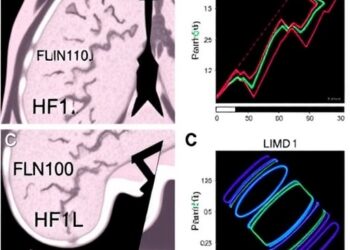A groundbreaking computational tool named “retriever” has shown promise in transforming how researchers identify effective drug combinations for cancer treatments. This innovative study, published in eLife, aims to refine personalized cancer therapies, targeting the unique characteristics of various cancer subtypes while enhancing therapeutic efficacy. The potential implications of this work are profound, as it could revolutionize the development of tailored treatments, offering hope to patients battling aggressive forms of cancer.
Current cancer treatment development is notoriously challenging, often involving extensive financial investment and time-consuming trial and error. Traditional drug discovery processes rely heavily on computational models that analyze transcriptional signatures, which are the variations in gene expression tied to specific diseases. These signatures help researchers match these genetic changes to the response profiles observed in different cell lines—models that mimic how actual cancer cells behave in response to pharmaceutical intervention. By synthesizing these insights, scientists aim to identify drugs that could restore normal cellular function.
One significant project aiding this process has been the LINCS-L1000 initiative, which compiled a wealth of transcriptional profiles from numerous cell lines subjected to hundreds of different drugs. By generating a rich dataset, LINCS-L1000 allows for the ranking of drugs based on their potential to reverse cancer-associated transcriptional alterations. However, despite its expansive database, LINCS-L1000 has a notable limitation; it lacks specificity in its predictions. The results are generalized across multiple cell lines without a clear connection to specific cancer subtypes, leading to possible mismatches in predicting drug effectiveness.
The research team, led by Daniel Osorio and based at the Centre for Molecular Medicine Norway, has developed the retriever tool to address this inherent limitation. The approach employed by retriever integrates single-cell RNA sequencing data, which captures detailed insights into gene expression at the individual cell level within a tumor. This method allows for the creation of disease-specific transcriptional signatures that enhance the accuracy of drug response predictions.
Retriever employs a three-step validation process to ensure its predictions are reliable and informative. Initially, it summarizes cellular responses following drug application across various time points, taking into account the kinetics of drug action. The second phase focuses on analyzing responses across different drug concentrations, which is critical for understanding dose-dependent effects. The final step of retriever’s methodology consolidates data from various cell lines, allowing researchers to derive more robust, disease-specific drug response profiles that are tailored for individual cancer types.
The promise of retriever became further evident when Osorio and his colleagues applied this tool to predict drug combinations effective against triple-negative breast cancer (TNBC)—a particularly challenging and aggressive cancer subtype known for its limited treatment options. By compiling existing single-cell RNA sequencing data from publicly accessible sources, they aimed to create a comprehensive database that could be analyzed for effective treatment strategies against TNBC.
In their experiment, the researchers combed through drug response profiles from TNBC cell lines documented in the LINCS-L1000 database. They meticulously adjusted for extraneous variables arising from different drug administration schedules, concentrations, and cell line types. This rigorous filtering process led them to identify a compelling combination of two kinase inhibitors—QL-XII-47 and GSK-690693. Their analysis indicated that this combination had a significant potential to revert the transcriptional profile of TNBC cells back to a state closer to healthy tissue.
Moreover, the research team undertook a Gene Set Enrichment Analysis to understand the mechanistic pathways targeted by the identified drug pair. Their results suggested that QL-XII-47 and GSK-690693 act on critical biological pathways essential for hindering TNBC growth and preventing metastasis. These findings were validated experimentally; the laboratory results showed that while both drugs reduced cancer cell viability individually, their combination had a substantially amplified effect, underscoring retriever’s capability in identifying synergistic drug interactions.
Despite the promise shown by the retriever tool, the researchers are cognizant of its current limitations. While it is proficient in ranking drugs based on their ability to counteract disease-associated transcriptional profiles, further experimental validation is required to optimize dosing strategies, understand drug synergy comprehensively, and evaluate potential adverse effects stemming from combination therapies.
In a broader context, retriever’s potential lies in its applicability not just for TNBC but also across diverse cancer types. This tool could facilitate personalized treatment strategies by identifying effective drugs for specific tumor subtypes and cellular characteristics. With the ability to analyze disease profiles derived from individual patients, retriever enhances the feasibility of precision medicine in oncology.
As the scientific community anticipates the advent of advanced single-cell RNA sequencing and increasingly comprehensive pharmacological data, the retriever tool stands poised to play a pivotal role in cancer research. According to Marieke Kuijjer, senior author and Group Leader at the Center for Molecular Medicine Norway, the tool’s design allows for its application to a variety of cancer types beyond TNBC, including prostate carcinoma and adult acute monocytic leukemia. The continuing enhancement of this research tool holds great promise for further refining therapeutic approaches and expanding the scientific understanding of cancer treatment.
Ultimately, the retriever tool is a significant stride forward in the realm of oncological research. It heralds a new era of personalized cancer treatment, offering unprecedented potential to identify precise and effective drug combinations that cater to the unique molecular landscape of individual tumors. As researchers continue to investigate and validate its predictions, retriever may become an instrumental resource in the ongoing battle against cancer, inspiring hope and ingenuity within the medical community.
Subject of Research: Cancer Treatment Drug Combinations
Article Title: Drug combination prediction for cancer treatment using disease-specific drug response profiles and single-cell transcriptional signatures
News Publication Date: 4-Feb-2025
Web References: None provided
References: None provided
Image Credits: None provided
Keywords: Cancer medication, Drug combinations, Transcriptional response, Discovery research, Cell lines, Tools, Cancer research, Breast cancer




